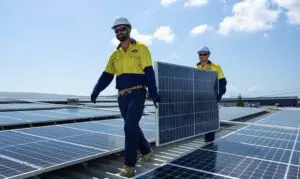The traditional coal hub of Newcastle may become home to a 40MW green hydrogen electrolyser, after the federal government backed a Macquarie-led consortium that is to conduct a feasibility study into the project.
Morrison government has committed $1.5 million in funding to support a feasibility study into the viability of a hydrogen hub located at the Port of Newcastle, but the Beyond Zero Emissions think-tank believes more needs to be done to cash in on a potential $11 billion “export industry bonanza”.
The Australian Renewable Energy Agency is providing $1.5 million in funding to support a $3 million feasibility study into the development of the 40MW green hydrogen hub proposed by Macquarie Group’s Green Investment Group, the Port of Newcastle, and other project partners.
The Port of Newcastle in New South Wales’ Hunter region is the largest port on Australia’s east coast and currently handles approximately 4,400 ship movements and over 160 million tonnes of cargo annually, much of it for coal.
But the Port only utilises less than half of its channel capacity, making it an ideal location for the development of a green hydrogen hub.
“This feasibility study which presents an opportunity to accelerate the diversification of Port of Newcastle which is crucial as Australia starts its journey to net zero by 2050,” said Darren Miller, the CEO of ARENA.
“Newcastle is an ideal location for this project due to existing infrastructure and skilled workforce, both of which will be so important as we scale up.
“With the backing of Macquarie’s Green Investment Group, Newcastle could become a hub for the production and use of hydrogen for domestic and export opportunities for Australia.”
Federal energy and emissions reduction minister said “clean” hydrogen (which most people see as different to “green hydrogen because it includes the use of CCS and fossil fuels) would provide “fantastic: export opportunities, and the chance to grow local industries such as ammonia for domestic fertiliser use.
“We expect the future Australian hydrogen industry to directly support more than 16,000 jobs by 2050, plus an additional 13,000 jobs from the construction of related renewable energy infrastructure,” said Taylor.
However, climate think-tank Beyond Zero Emissions (BZE) said the government should think bigger and support a larger Hunter Renewable Energy Industrial Precinct.
It said this would be able to build on the region’s existing mining, energy, and manufacturing expertise, and support industries such as battery manufacturing, green chemicals, green steel, and green aluminium.
“Our modelling shows that a Hunter Renewable Energy Industrial Precinct would generate $11 billion a year in revenue by 2032, create 34,000 new jobs, and attract $28 billion in capital,” said Sam Mella, Beyond Zero Emissions Hunter Project Manager.
“Across Australia, Renewable Energy Industrial Precincts could grow a new green export market worth $333 billion a year by 2050 – almost triple the value of our current fossil fuel exports.”
According to BZE, the Hunter region is facing a major structural change, and a green hydrogen industry has the potential to unlock significant development and act as an industrial feedstock while also providing grid flexibility.
“Newcastle and the Hunter region have a great future if we continue to build on its industrial strengths,” said Mella. “It really is a case of back to the future here.
“Newcastle was built on energy and steel, and we also have a world-leading university and excellent research capability. Newcastle has the infrastructure, the port, the grid to plug in renewables, and a highly trained workforce.
“We can become a major steelmaker again, making it with renewable energy and meeting the increasing international demand for low emission products.”









